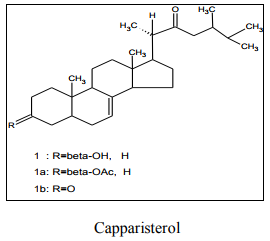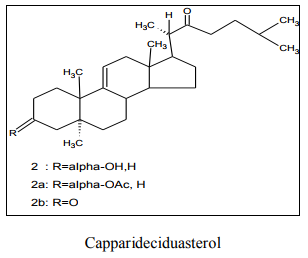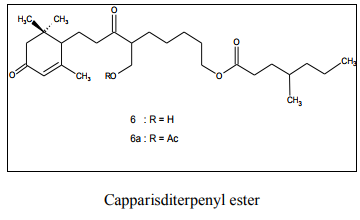IJCRR - 2(3), March, 2010
Pages: 16-25
Print Article
Download XML Download PDF
CAPPARIS DECIDUA EDGEW- A WILD MEDICINAL PLANT
Author: Sandeep B.Patil , Nilofar S.Naikwade, Chandrakant S.Magdum
Category: Healthcare
Abstract:Medicinal herbs are the local heritage with global importance. World is endowed with a rich wealth of medicinal herbs. The different variety of plants with therapeutic properties is quite astonishing. In general, natural drug substances offer four vital and appreciable roles in the modern system of medicine thereby adequately justifying their legitimate presence in the prevailing therapeutic arsenal, namely: Serve as extremely useful natural drugs, Provide basic compounds affording less toxic and more effective drug molecules, Exploration of biologically active prototypes towards newer and better synthetic drugs, Modification of inactive natural products by suitable biological/ chemical means into potent drugs. Capparis decidua has widely medicinal uses like as analgesic, anthelmintic, laxative and cardiac troubles etc.
Keywords: napti, Capparis decidua , phytochemistry, traditional and modern uses.
Full Text:
INTRODUCTION:
On a recent survey conducted by the world Health Organization (WHO) globally, around 20,000 medicinal plants are being used profusely either in pharmaceutical industry or in folk medicine. Interestingly, about 1.4% do possess well established, widely-proven and broadly accepted un-equivocally active constituents1 . The world health organization (WHO) estimates that about 80% of the populations living in the developing countries rely almost exclusively on traditional medicine for their primary health care needs. In almost all the traditional medicine the medicinal plant include the fresh or dried herb part, whole, chopped or powdered, or an advanced form of the herb usually made via extraction by a solvent such as water, ethanol or an organic solvent (eg. acetone), play a major role and constitute the backbone of the traditional medicine2 . A large genus of about 270 species of trees and erect, climbing shrub, distributed throughout warm regions of the earth. About 40 species occur in the India of which a few are of economic importance3,4 .
Taxonomy:-
Current name: - Capparis decidua Authority: - (Forssk) Edgew Family: - Capparidaceae
Synonyms: (S) Capparis aphyla (Heyne) Roth Capparis sodada R.Br. Sodada decidua Forssk.
Other names:
Sanskrit: Karira, Marathi: Nepati, Hindi: Karil, Kurel, English: Caper plant, Caper berry, Malayalam: Karimulli, Karimullu, Tamil: Sengam, Sirakkali, Arab: KiaBara, Punjab: Karia, Kannada: Chippuri
Occurrence and Distribution: History of cultivation: -
Capparis decidua is one of the important multipurpose tree species of desert and arid regions of the Indian subcontinent. It provides vegetative cover in dry, hot, sandy desert areas where little else grows and is an extremely hardy species.
Geographic distribution:-
Native: Chad, Egypt, Ethiopia, India, Iran, Jordan, Mauritania, Niger, Nigeria, Pakistan, Senegal, Somalia, South Africa, Sudan and In India from Punjab to South Karnataka, Gujarat, Maharashtra and Tinnervelly
Biophysical limits:
Altitude range: 300-1200m, Mean annual rainfall: 100-750mm, Mean annual temperature: 25-31oC, Soils: it prefers alkaline, sandy and gravelly soils, thriving on shallow, hard soils and rocky outcrops.
Reproductive biology:
Flowering occurs at the beginning of dry season5 .
Description:
A climbing shrub with vine- like branches hanging in bundles. Bark: The bark is greenish- yellow and smooth. The thorns are paired, pale brown, straight or hooked and to 0.5 cm. Leaves: there are only leaves on young shoots that are small and narrow and soon fall off. Leaves only appear during shorts rain. Flowers: flowers are pinkred, single or in threes beside leaves and about 1cm across. Flowers appear at the beginning of the dry season. Fruits: fruits are red and rounded, about 1cm across, black when ripe and dry. Seeds: seed numerous embedded in the pulp6 . Androecium- stamens many, polyandrous, attached on a disc at the gynophore base, dithecous, dorsifixed, introrse. Gynoecium- bicarpellary, syncarpous, superior, unilocular, parietal placentation, develop on a long gynophore, style short, stigma bifid.7 fruits eaten locally.8 Sodad (arab) fruits are consumed by the sudanes. Buds are cooked when fresh as pot herb. Young flower buds are preserved as pickles or condiment. 9
Phytochemistry:
Some species of Capparis appears have been investigated chemically and the isolation of Stachydrine, β-carotene, Rutin, Isothiocynate, Glucosides, Hydrocarbons and Fatty acids. The bark of Capparis decidua (Forssk) Edgew contains Capparisine, Codonocarpine, Cadabicine and Isocodonocarpine (a new spermidine alkaloid) 10 . Two sterols (Capparisterol, Capparideciduasterol), one diterpine alcohol (Capparisditerpenol), two aliphatic constituents (Butyl-3- oxoeicosanoate, Aliphatic hydroxyl ketone) and one diterpinic ester (Capparisditerpenyl ester). All the new compounds have been reported for the first time from the alcoholic extract of C.decidua. Also β-sitosterol, indole bases, and oxygenated heterocyclic compounds have been reported from the root bark of the Capparis decidua11 . Capparis decidua fruit is of high nutritional value. The edible fruits are rich in protein and minerals and have a high seed fat content. Seed contents 20% oil, 1.7% sugar and 8.6% protein12
Figure of chemical constituents:








Traditional Medicinal uses of this plant:
All parts of the plant like leaves, fruits and root bark are used to relieve a variety of ailments such as cough, asthma, intermittent fever and rheumatism.13 Traditionally in Ayurveda, this plant was mentioned as analgesic, diaphoretic (increase in sweating), laxative, anthelmintic, good in cough and asthma, ulcers and boils, vomiting, piles and all inflammation urinary troubles, antidote to poison, cardiac troubles, and infections of joints. Traditionally in Unani, this plant has a bad smell and taste; carminative, tonic, emmenagogue, aphrodisiac, improves the appetite; good for rheumatism, lumbago, hiccough, cough and asthma.14 Plant used in heart diseases, colicky pain and loss of appetite and scurvy. Root bark in powder form is used in rheumatism, gout, dropsy, palsy, and haemostatic. Externally the powder is applied to malignant ulcers. Juice of the fresh plant is dropped into ear to kill worms. 15 Young shoots used as plasters for boils and swellings. Powdered plant parts are useful in toothache. Bark is useful for cough and asthma. Root bark is given in intermittent fever.16
Modern uses of this plant:
The plant has been reported as it is an unripe fruit of Capparis decidua is a xerophytic bush. It contains 15.1% protein and 42.88% fibre. Being a rich source of fibre, the process for preparation of fruit powder and other recipes were standardized for feeding hyperlipidemic subjects. The diet of 15 hyperlipidemic adults (40-60 yrs.) was supplemented with fruit for three months and plasma triglycerides, total lipids and phospholipids were analyzed before and at the end of the experiment. Significant reductions in plasma triglycerides, total lipids and phospholipids concentration were noticed.17 The fruit of Capparis decidua was found to be the richest source of beta carotene and vitamin C.18,19 Antidiabetic treatment with powered fruit of Capparis decidua decreased alloxan induced lipid peroxidation (LPO) significantly in erythrocytes, kidney and heart. Erythrocyte superoxide dismutase (SOD) activity decreased while the kidney and heart (SOD) increased in diabetic animals. These alterations in Superoxide dismutase were counteracted by insulin as well as with powdered fruit of C.decidua. Increased Catalase (CAT) activity in erythrocytes, liver, kidney and heart with powdered fruit of Capparis decidua treatment indicate that the treatment may neutralize H2O2 toxicity by its increased decomposition by CAT.
Result shows that treatment with Capparis deciduas lowers alloxan induced LPO and alters SOD and CAT enzymes to reduce oxidative stress20,21 . The Capparis deciduas fruit contains dietary fiber foods like hemicellulose. Capparis decidua has the most pronounced hypocholesterolemic effect which appeared to operate through increased fecal excretion of cholesterol as well as bile acids22,23. The ethanolic extract of root bark of Capparis deciduas of possesss significant anti-inflammatory activity against carrageenan induced edema in rats24 .
CONCLUSION:
Most people know the uses of medicinal plant over the years. The nature is true wealth of man and has many mysteries to its credit. For every problem of man and disease there is a cure in the beautiful and wonderful nature. With the passage of time, man is exploiting nature to the utmost.
References:
1 Kar Ashutosh, -Pharmacognosy and Pharma biotechnology?, New age International (p) Ltd, New Delhi, P.5, 11.
2 Mukherjee PK, -Quality control of Herbal Drug?, Business Horizon Pharmaceutical Publishers, 1st edition, 2002, P.2.
3 Shastri BM. -The wealth of India, A dictionary of Indian raw materials and industrial products?, CSIR, New Delhi, 1995, P. 210- 212.
4 Isaac kehimkar, -Common Indian wild flowers?, Bombay natural history society, oxford university press, Mumbai ,2000, P.no. 36.
5 Vogt KA, -Field guide to the identification, propagation and uses of common trees and Shrubs of dry land Sudan?. SOS Sahel international (UK), 1995.
6 Oudhia P, Medicinal herbs of Chhattisgarh, India having less known traditional uses (Capparis deciduas Edgew family capparidiaceae). Ethnobotany, (03),2005, P.2
7 Jagdale SV., Bachulkar MP., Hardikar KS. , Dhere RS., Mane PN., Modarn Botany paper III and IV Narendra Prakashan, Pune, P.7- 8.
8 George usher, -A dictionary of plants used by man?, CBS publishers and Distributors, Delhi. P no. 121.
9 Tyozaburo tanaka, Tanaka's Cyclopedia of edible plants of the world, 1976, Keigaka publication, Tokyo, Japan.
10 Ahmad VU, Nargis ismail and A.U. Rahman Amber, "Isocodonocarpine from Capparis deciduas Phytochemistry, 1989; 28(9):P. 2493.
11 Gupta J. and Ali M. , -Phytocostituents of Capparis Decidua Root barks?, Journal of medicinal and aromatic plant sciences, 1998; 20: P. 683-689.
12 Rai et al., 1987 and Chauhan et al., 1986 in Scoones et al., 1992 The Hidden Harvest: P. 127, 138.
13 Durga N. Tewari R.P. Tripathi R.D. and Ahuja A.P. Proc. Nat. Acad. sci. (42), 1972, P. 24.
14 Kirtikar K.R., Basu B.D. -Indian medicinal plant?, 2nd edition, VolI, 1975, P.210.
15 Nadkarni K.M., -Indian Materia Medica?, vol. I, Bombay popular Prakashan 1976 P.265.
16 Singh, U., Wadhwani A. M. and Johri B. M.-Dictionary of Economic Plants in India?. Indian Council of Agricultural Research, New Dehli,1983, P. 288.
17 Goyal R, Grewal R.B. - The influence of Teent (Capparis decidua) on human plasma triglycerides, total lipids and phospholipids?, Nutr. Health. 2003; 17(1): P.71-76.
18 Chaturvedi Y. Ngar R. - Levels of beta carotene and effects of processing on selected fruits and vegetables of the arid zone of India?, Plant Foods hum Nutr., 2001;56 (2): P.127-132.
19 Duhan A., Chauhan B.M., Punia D.-Nutritional value of some nonconventional plant foods of India.? Plant foods hum Nutr. 1992 ; 42 (3):193-200.
20 Yadav P., Sarkar S., Bhatnager D., -Lipid peroxidation and
|






 This work is licensed under a Creative Commons Attribution-NonCommercial 4.0 International License
This work is licensed under a Creative Commons Attribution-NonCommercial 4.0 International License